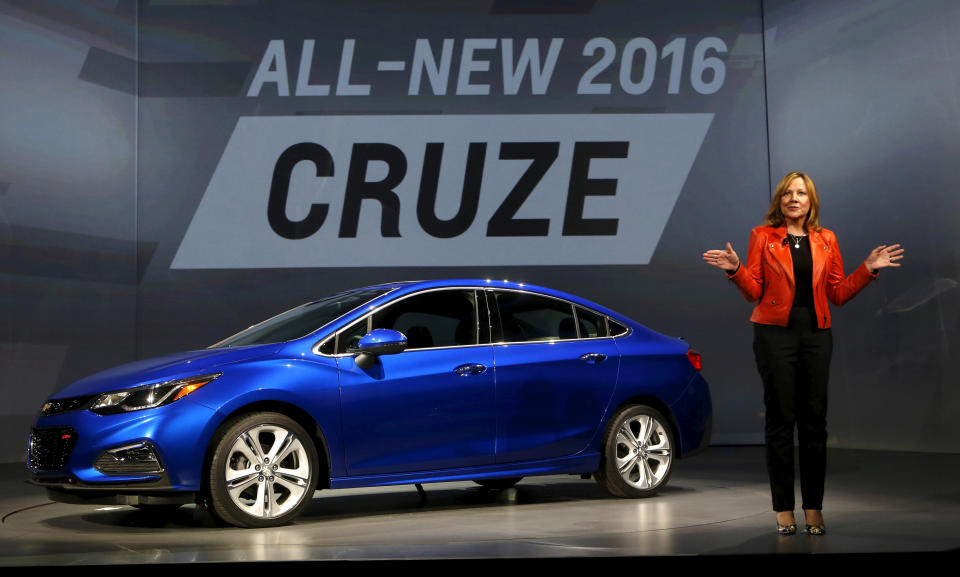Trump has the GM problem backward
President Trump wants General Motors (GM) to continue building money-losing cars nobody wants to buy in order to save several thousand industrial-era jobs. It’s the exact opposite of what Trump should be encouraging American companies to do, and it’s the wrong message for workers, too.
Trump is fuming after GM said it plans to close factories in Maryland, Michigan and Ohio (combined electoral votes: 44) and discontinue slow-selling models built at those plants, such as the Chevrolet Cruze and Cadillac CT6. The plant closures would affect about 6,700 workers, some of them in places such as northeastern Ohio, where there’s not a lot of other opportunity.
Trump tweet-threatened to cut federal subsidies for electric cars GM sells, and said he was “very disappointed” in GM and its CEO, Mary Barra. But Trump can’t single out one company to be excluded from subsidies Congress established by law. And while he can certainly browbeat the automaker—as he has Harley-Davidson, Amazon, Google and other big firms that earn his disfavor—GM, as a public company, owes its loyalty to shareholders, not the president.
Trump is also offering lousy business advice. GM knows better than most companies the danger of excess manufacturing capacity and an outdated product portfolio. Those factors contributed to its epic bankruptcy filing in 2009. GM wants to retool now to keep up with the shift from passenger cars to SUVs and crossovers, and invest more in self-driving and electric cars as those become viable technologies. It is divesting in the past and focusing on the future.
[See why GM is killing the family sedan, too]
Living in the past
Trump loves the past, however, especially the industrial economy of the 1970s and 1980s. His trade policy is designed to bring back assembly-line jobs in smokestack industries such as steel, coal and automobiles. But private-sector companies that compete on price, quality and relevance can’t just stick with what worked before. The latest poster child for corporate obsolescence is General Electric, a once colossal conglomerate that is now too big to adapt and possibly at risk of bankruptcy.

Trump apparently wants GM and other manufacturers to be more like GE, and keep old-line manufacturing operations in place indefinitely. Here’s what he might do, instead: Encourage GM and all American firms to innovate relentlessly so the United States gains and keeps a lead on key future technologies. And instead of punishing companies for trying to plan for the future, he could develop new policies that help workers build new skills and become better equipped for the future themselves.
It’s a tough blow when communities lose a single source of mass employment, such as an auto plant. But companies have to modernize, get more efficient and move resources around if they want to stay competitive, which has been a reality of free-market capitalism forever. Some towns recover from such shocks by retooling themselves—luring new employers, partnering with universities, establishing technology hubs and training workers for new types of employment. Federal incentives can help with that.
Workers must adapt, too
Workers have to do their part, too. With the rapid pace of change these days, few people can earn a stable living doing the same thing for 40 years. Trump is sending the wrong message to workers by suggesting he can intervene to protect their jobs and livelihood. Taken to an extreme, that approach would eventually lead General Motors off a cliff and harm every one of the company’s 100,000 or so American workers. It would be more realistic to tell workers they can still find good opportunities, as long as they regularly learn new skills and are willing to move where the opportunity is–as ambitious Americans have done since the founding of the country. The American Dream, after all, is not a guarantee that a rewarding job will come to you, wherever you happen to be.
There could scarce be a better time for Trump to futurize his economic policies and encourage displaced workers to modernize themselves. The unemployment rate is a super-low 3.7% and many companies say they can’t find enough workers. There are 7 million open jobs in America—that’s 1,045 jobs for each one of the 6,700 assembly-line workers likely to be left out of work by the GM plant closures. There’s plenty that Trump, along with state and local leaders, could be doing to match displaced workers with companies that would love to hire them.
But it’s easier to bash a company for putting profits over politics (which is what publicly owned companies are supposed to do) and feign empathy for displaced workers. If Trump really cared about those workers, he’d want them to build a bulletproof repertoire of skills and work for the most advanced companies in the world. Instead, he seems to prefer that they forever live in the past, where it’s only going to get less hospitable, not more.
Confidential tip line: [email protected]. Click here to get Rick’s stories by email.
Read more:
Rick Newman is the author of four books, including “Rebounders: How Winners Pivot from Setback to Success.” Follow him on Twitter: @rickjnewman
